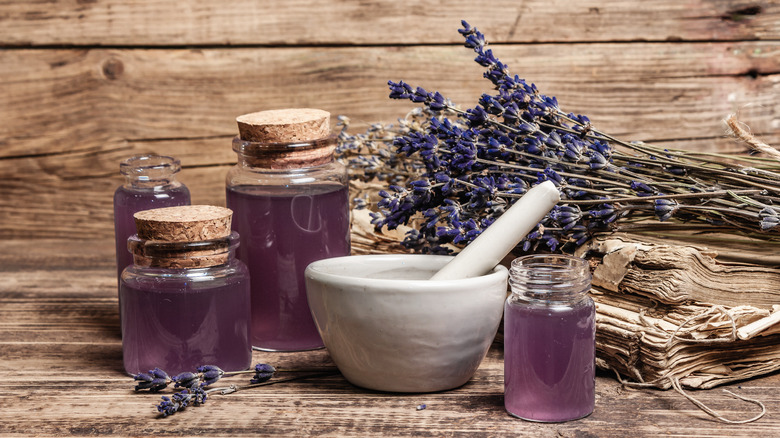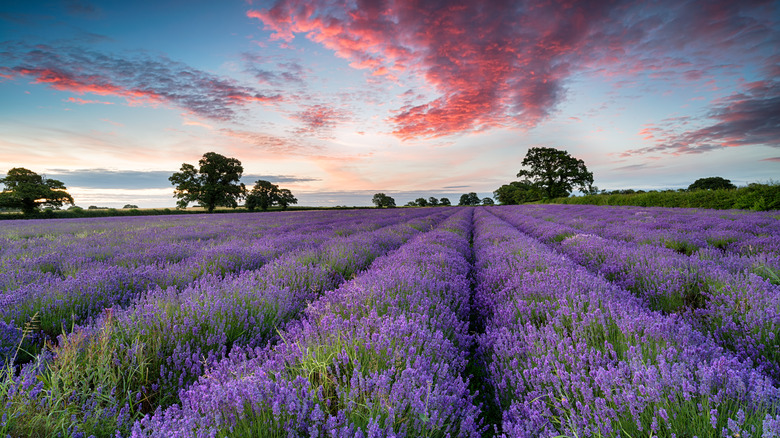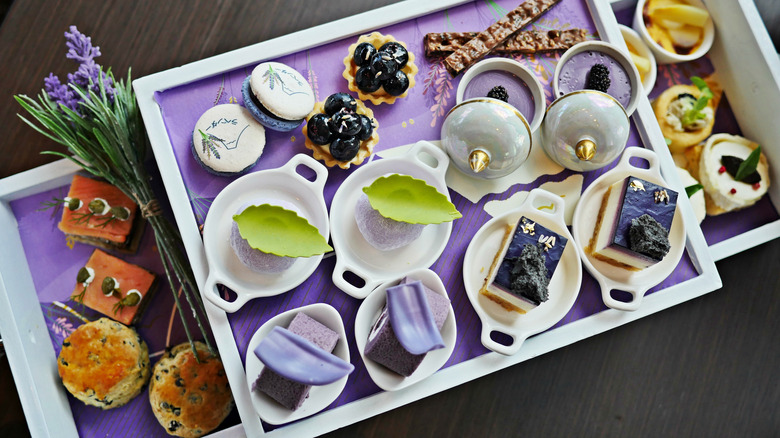The Importance Of Using Culinary Lavender Vs Other Lavender
Lavender is like a breath of fresh air. Its heady scent exudes a warm, sharp, powerful aroma universally linked with cleanliness. It is a frequent ingredient in fine French-milled soaps, luxury toiletries, sachets, scented sleep masks, and colognes for men and women. Not only does lavender have a clean fragrance, it has genuine antiseptic properties making it the perfect natural ingredient in cleansers for the home and body, states Organic Facts, who goes on to say that lavender is stimulating to the skin and scalp, leaving your hair lustrous. In fact, Bon Appétit reports that the word lavender is adapted from the Latin verb lavare which means to wash.
In folklore, lavender is a magical herb that bestows love, longevity, protection, peace, and slumber, upon those who carry a sprig or two, according to the "Encyclopedia of Magical Herbs," by Scott Cunningham.
In reality, lavender is good for you: lavender is a nervine that reduces stress and anxiety, making it a calming yet gentle sedative and therefore good for insomnia. It is high in antioxidants and has anti-inflammatory properties. It is shown to be heart healthy because it reduces blood pressure and atherosclerosis, when combined, these attributes go a long way in preventing heart disease and strokes. Healthline suggests drinking calming teas and using lavender essential oil for aromatherapy and spa treatments.
47 types of lavender and 450 varieties
Lavender is a versatile, hearty plant that thrives in sunny and dry locales. Its sweet yet pungent scent attracts hummingbirds, honeybees, and butterflies, adding beauty and a liveliness to any garden. Gardening Chores indicates that while all lavender has its signature soapy aroma, there are 47 types of lavender and about 450 varieties, each with their unique look and fragrance characteristics. Some of these lavenders are highly aromatic and best suited to cosmetics and natural air fresheners like potpourri, while others make delectable culinary treats.
The most abundant lavender varieties are English, French/Spanish, Portuguese, and lavandin. French or Spanish lavender (lavandula stoechas) has lush, full flowers and a rich, dense aroma. Portuguese lavender (lavandula latifolia) is prized for its pungent woodsy scent. Lavandin (lavandula x intermedia), a hybrid cross between English and Portuguese lavender, is the most aromatic variety with a strong soapy scent, and borders on camphor mintiness. Lavandin is popular in Provence, France, and finds its way into French soaps and cosmetics. English lavender (lavandula angustifolia) has delicate purple pink, or white flowers and gentle fragrance used for the finest essential oils.
The best culinary lavender
Rural Sprout reveals that there are dozens of delicious edible flowers in your garden and lavender is one of them! Lavender is a sweet scent when used in moderation, and it is strong and can be perceived as soapy. Make sure you are using culinary lavender in your recipes. Most types of lavender are simply too strong. Bon Appétit says that the best culinary lavender is English lavender (lavandula angustifolia) because it has a restrained aroma and less essential oil in its delicate flowers. They indicate that dried lavender flowers are "about three times as potent as fresh ones." In other words, use restraint in your recipes.
English lavender makes delicious syrups, infused sugar and chocolates, and is a gorgeous addition to all types of baked goods and confections including scones, biscotti, pie, crèmes, jellies, and sorbet. Lavender flowers can be crystallized for a beautiful garnish. Lavender has become a popular ingredient in non-alcoholic and alcoholic craft cocktails. Not just for sweet confections, lavender is one of the ingredients in the classic Herbes de Provence blend and is a popular culinary herb for savory dishes too. It is a perfect ingredient in herbal spice rubs for light and dark meat but due to its pervasiveness, it can overwhelm most fish and seafood. Use it sparingly as a seasoning sprinkled over roasted root vegetables and mushrooms. It can be added to vinaigrette dressings or marinades for a warm and spiky flavor.


